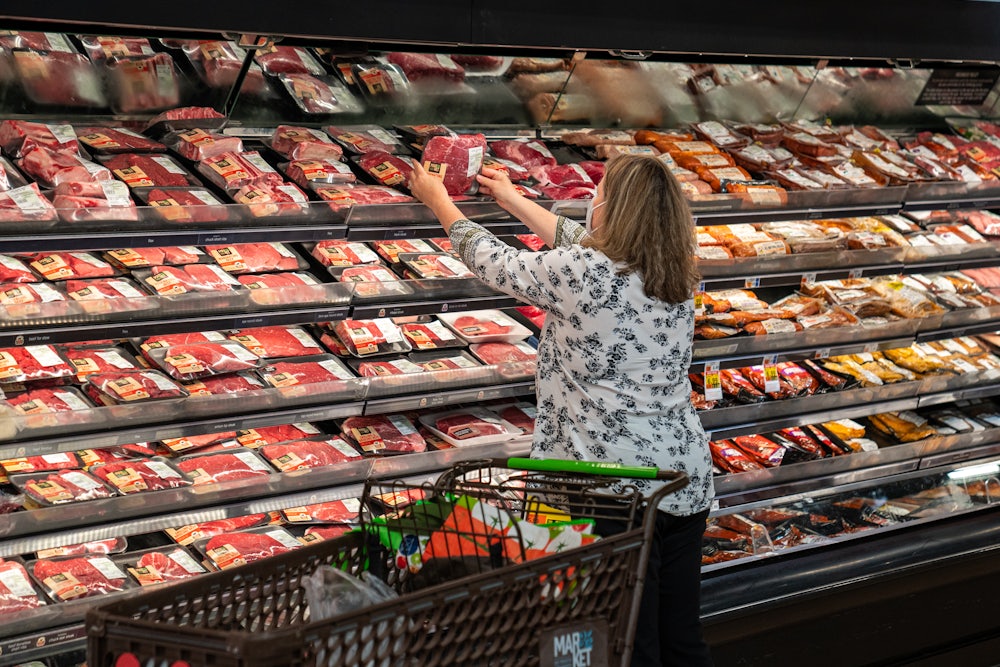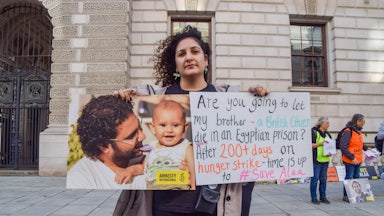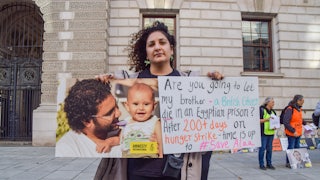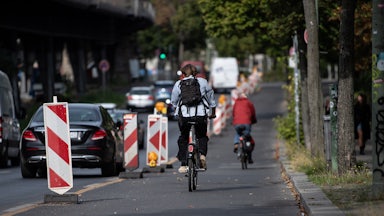For years, meat producers have worked furiously behind the scenes to keep meat reduction out of discussions on climate policy. The first draft of the 2021 Intergovernmental Panel on Climate Change’s report on climate change mitigation recommended shifting to plant-based diets and agricultural systems. Delegates dispatched by then-Brazilian President Jair Bolsonaro—who presided over a mass burning of the Amazon rain forest, in part by beef producers—helped get that phrase removed. The IPCC flinching in the face of lobbying allowed the same ambivalence toward agriculture to carry over into that year’s Conference of the Parties for the U.N. Framework Convention on Climate Change, which was focused on establishing a framework to reduce methane emissions: Despite the fact that animal agriculture emits a third of global methane and that it is impossible to meet emissions targets without addressing the food sector, the question of the industry’s contribution to anthropogenic climate change was conspicuously left off the policy menu—even though food options offered to conference attendees were paired with a carbon calculator.
The public is well aware, at this point, of fossil fuel lobbyists’ obstructionism on climate policy. We know, for instance, that there were more fossil fuel lobbyists than delegates for any country at COP26 and that the number has increased further at this year’s COP27. It’s harder to run the numbers on those representing the meat industry. Their influence, however, is evident.
The plan President Biden announced on Friday at this year’s COP27—which to its credit is putting food on the agenda—set specific goals for energy but was conspicuously vague on agriculture. The president merely said he intended to expand the country’s domestic programs for “climate-smart” agriculture globally—domestic programs that Agriculture Secretary Tom Vilsack has previously said would not require any reduction in meat production. This is in line with last year’s methane pledge, which set strict new standards for energy and waste sectors but approached agriculture “through technology innovation as well as incentives and partnerships” with corporations like Bayer and JBS, a double standard celebrated by meat industry lobbyists.
As criticism of animal agriculture and its contribution to climate change has ramped up in recent years, so has the industry’s counteroffensive. Drawing on the playbook developed by the fossil fuel industry during its 50-year campaign to sow doubt about the role of fossil fuels in climate change, the meat industry is now using dodgy science paired with savvy public relations to convince everyone, from the public to world leaders, that we should do anything other than the one thing scientists agree we need to do: scale down the meat sector.
One of the most effective tactics employed by the meat lobby is the use of creative accounting methods to obscure its climate impact. Because some greenhouse gases are stronger than others, when quantifying emissions, climatologists use a quotient called global warming potential, or GWP, to boil everything down to a single figure: carbon dioxide equivalent, or CO2e. Since gases like methane contribute to rapid heating but break down in the atmosphere, GWP changes depending on the time frame. For instance, while the global warming potential of methane over 100 years, GWP100, is 28 times that of carbon dioxide, over 20 years, methane is approximately 86 times as powerful as CO2. The 100-year figure is what’s typically cited, but many climatologists assert that this downplays the importance of reducing methane and nitrous oxide pollution in the immediate future, as we don’t have a century to stop climate change.
Methane’s biggest emitters, including the meat industry, don’t stop there in downplaying methane’s damage. Rather than use the GWP100 figure, which already underestimates heating from methane, they prefer a different one: GWP*. GWP* was developed because although GWP is the universal tool for counting emissions from a country, industry, or company, it doesn’t work well for modeling, since it can’t capture the transience of gases like methane. The new quotient, GWP*, is instead a tool for predicting global temperature change. Since the planet doesn’t heat more when methane levels are stable, the GWP* of a constant methane level is zero. The meat industry quickly realized this meant that as long as methane emissions didn’t rise it could claim it wasn’t contributing to global warming, and began lobbying for its use as an accounting metric—not what it was designed for at all. Funneling millions of dollars through back channels, the animal agribusiness lobby has financed the promotion of GWP* as the new greenhouse gas accounting standard, through groups ranging from U.C. Davis’s CLEAR Center to the lobbyists at COP. Challenging the conventional climate calculus helps the meat industry not only to downplay its emissions but to seed the suspicion that IPCC statistics unfairly malign the industry.
The second line of defense that the meat industry has been promoting focuses on technological fixes for the environmental damage caused by livestock. In the case of methane, the industry has rushed to fund research into seaweed-based feed additives for cows, aimed at reducing the methane produced by their digestive systems. But while industry pilot studies estimated the emissions-reduction potential of such additives as high as 80 percent at the feedlot stage, they didn’t mention that this translates to life-cycle emissions cuts of only around 9 percent. The industry is quick to drum up positive press to suggest that all it will take to make cows climate friendly is some algae or methane-capturing masks for cows, but these fixes are far from being widely viable or scalable. In all these cases, the needed environmental improvements can’t be achieved by quick fixes. Yet by aggressively pushing its message to journalists and businesses, the meat industry has prolonged the debate over the environmental sustainability of meat by suggesting that the environmental impacts of animal agriculture aren’t fundamental features, just inconvenient bugs.
But perhaps the most egregious tactic of the meat lobby is to sell itself as the solution to the problems it creates. Factory farms and industrial feedlots, by concentrating thousands of animals in confined spaces, also create massive manure lagoons that both generate methane and leach into or are outright dumped into waterways, contributing to the so-called dead zones expanding from river deltas. But while scientists stress the need to reduce animal waste, the industry has succeeded in securing lucrative tax exemptions for increasing it, touting the ostensible environmental benefits of refining manure into methane biogas, turning waste into an income stream. Due to successful lobbying, methane digesters have been classified under Biden’s Inflation Reduction Act as renewable energy generation, complete with huge tax credits incentivizing expansion of factory dairies, the industry excitedly projecting that “milk has become the by-product of manure production!”
Similarly, so-called carbon farming has become a cash cow for the ranching sector. While international panels of experts and even the industry’s own research shows that sequestering carbon in soil can’t persist for any meaningful timescale, the industry still insists that ranching can become carbon negative with proper management. Carbon credits are now traded like stocks in speculative markets, with both agribusiness and oil backing them as a tool for emissions reduction. The USDA provides carbon credit calculators to assist ranchers in qualifying and buying in—helping them, or whoever buys their credits, to erase their emissions with carbon offsets based on sketchy assumptions and self-reported data. Like seaweed additives, carbon farming generates reams of good press for the industry. And by greenwashing their operations as climate solutions, the meat and dairy sectors can frame their critics as hostile not just to their industries but to climate progress itself.
In this battle over policy and public opinion, scientific claims are wielded as weapons and the industry is itself a weaponsmith, funding the research and scientists that fight in its corner. Both the tobacco industry and the fossil fuel industry have spent heavily on scientists and experts who would push out research and arguments to defend their interests—sometimes even using the same experts. The meat industry—which starts with the advantage of already having close links with land-grant university agriculture and animal science programs—invests in research under the banner of reducing its carbon footprint. Yet this research is also used—arguably, designed, in fact—to challenge critique in the court of public opinion. One recent bombshell investigation from Greenpeace Unearthed, for example, detailed how a livestock-feed lobbying group conceived and financed a communications center at U.C. Davis and used it to spread disinformation on the meat industry’s impact on climate. On the global stage, the livestock sector wields considerable influence within international organizations like the U.N. Food and Agriculture Organization, which promotes the industry pursuing public-private partnerships for agribusiness development, unlike other U.N. organizations’ approach to energy.
This problem goes beyond one single scholar or even one single academic center. In 2017, industry finance overtook public grants to fund the majority of research in the United States for the first time in almost a century. The corporate long game to supplant public science has succeeded in transforming not only the output but the culture of academia. Researchers become reluctant to criticize even the most egregious science corruption scandals when they know their own grants come from private institutions as well. This pattern erodes public trust in scientific institutions, which in turn benefits industry: By creating space for uncertainty, corporations funding misinformation about their products can then demand seats at the political table and the representation of “both sides” in media.
When the science became unequivocal that cigarettes and their secondhand smoke were carcinogenic, the tobacco industry sought to challenge these findings, funding its own research and lobbying to cast doubt on the emerging scientific consensus. This delay in meaningful regulation likely caused millions of avoidable deaths. These tactics of delay and agnotology—deliberate ignorance, rather than the organic absence of knowledge—were picked up by the fossil fuel industry, which has regularly employed lobbyists and scientists to challenge the consensus on the role of fossil fuels in driving climate change. These ongoing delay tactics have helped prevent binding regulation and set us on a course to miss the target of keeping warming to 1.5 degrees Celsius (2.7 degrees Fahrenheit). The historians Naomi Oreskes and Erik Conway dub those who challenge scientific consensus and muddy the public discussion on behalf of harmful industries “merchants of doubt.” Their game is not necessarily outright denial but active, perpetual equivocation. The goal is to drag out the debate and introduce doubt where there shouldn’t be any in order to defend the status quo.
Amid global climate and extinction crises driven in part by animal agriculture, the meat merchants of doubt have thoroughly succeeded at this goal: Their interests have infiltrated the highest echelons of global politics, and their ideas have taken root in public discussions about the food system. In recent years, activists have made progress identifying and abating the influence of the fossil fuel industry from media and academia—through campaigning for divestment, tracking political contributions, demanding news coverage, and more. Now we must do the same for meat. The good news is that we know their strategy. The bad news is that we’re running out of time.










